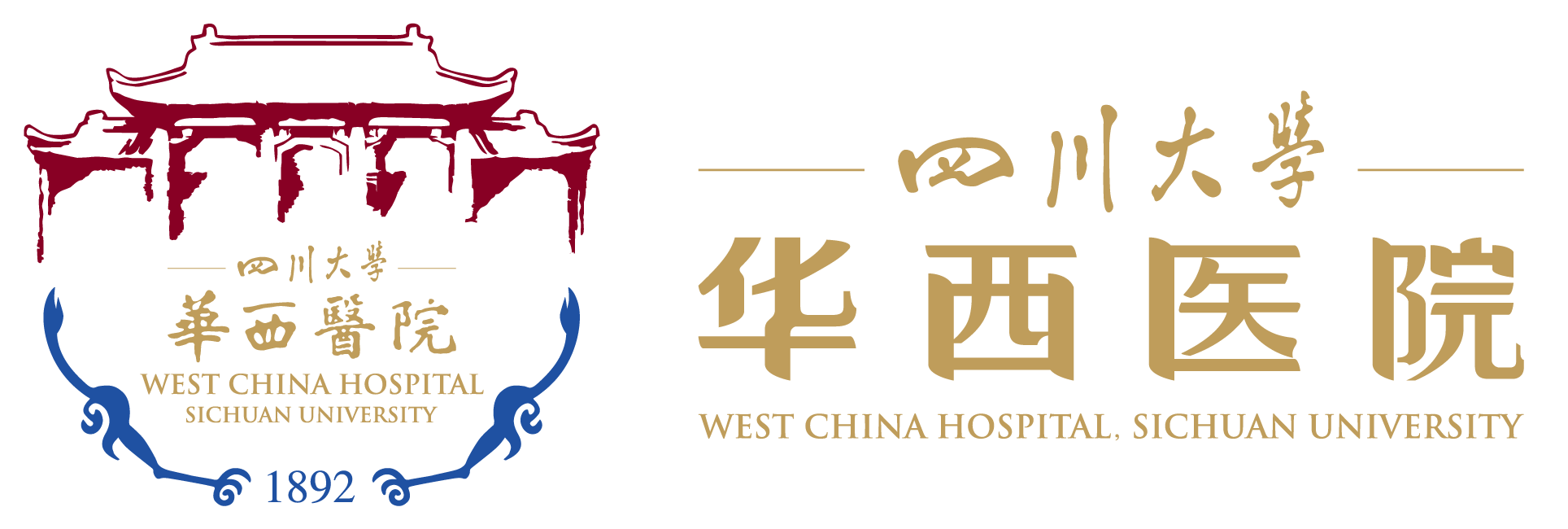原创 向琳 华西医院耳鼻喉科
华西耳鼻喉前沿学术速递——文献导读(第63期)
【Cancer cell】2024年10月-2024年12月刊论文导读
期刊介绍:
Cancer Cell创刊于2002年,由CELL PRESS出版商出版,收稿方向涵盖医学-肿瘤学全领域,在行业领域中学术影响力很大,属于TOP期刊,国际一流期刊。审议手稿的主要标准是研究是否在回答与自然发生的癌症有关的重要问题方面取得重大进展。影响因子指数48.8。
2024年10-12月一共发表45篇文章,包括Commentaries 4篇,Letter 1篇,Previews 11篇,Spotlights 2篇,Review 2篇,Articles 18篇,Reports 3篇,Letter 1篇,Perspective 1篇,Correction 1篇, Editorial Note 1篇。
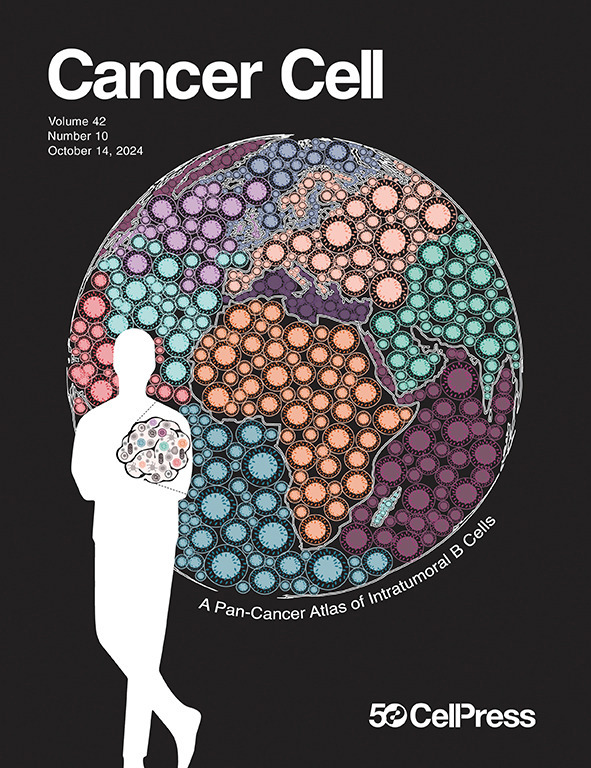
Oct 14, 2024 Volume 42 Issue 10
其中Commentaries 2 篇,Previews 4 篇,Review 1 篇,Articles 6 篇,Report 1 篇,共14篇。
1.Coagulation factor X promotes resistance to androgen-deprivation therapy in prostate cancer
凝血因子X增强前列腺癌对雄激素剥夺治疗的耐药性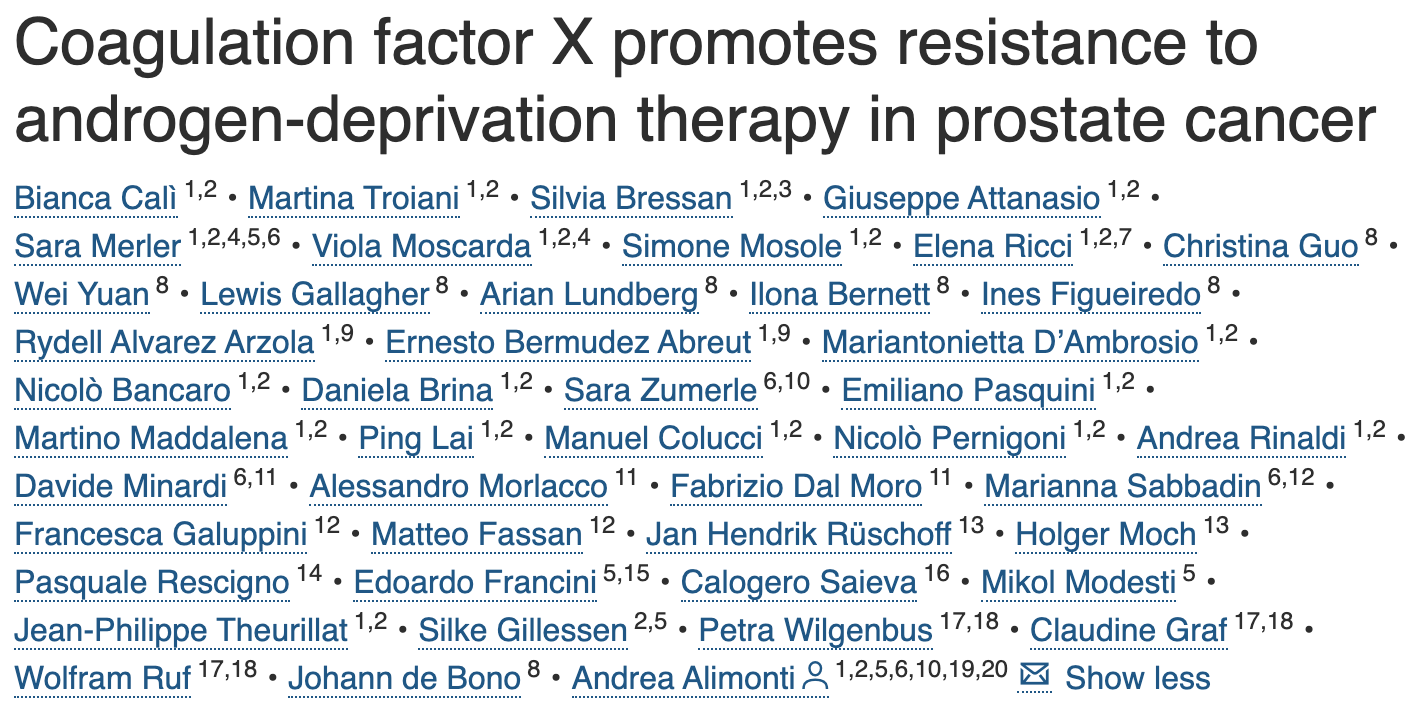
瑞士卢加诺大学(USI)生物医学科学学院以及肿瘤研究所
Summary
Although hypercoagulability is commonly associated with malignancies, whether coagulation factors directly affect tumor cell proliferation remains unclear. Herein, by performing single-cell RNA sequencing (scRNA-seq) of the prostate tumor microenvironment (TME) of mouse models of castration-resistant prostate cancer (CRPC), we report that immunosuppressive neutrophils (PMN-MDSCs) are a key extra-hepatic source of coagulation factor X (FX). FX activation within the TME enhances androgen-independent tumor growth by activating the protease-activated receptor 2 (PAR2) and the phosphorylation of ERK1/2 in tumor cells. Genetic and pharmacological inhibition of factor Xa (FXa) antagonizes the oncogenic activity of PMN-MDSCs, reduces tumor progression, and synergizes with enzalutamide therapy. Intriguingly, F10high PMN-MDSCs express the surface marker CD84 and CD84 ligation enhances F10 expression. Elevated levels of FX, CD84, and PAR2 in prostate tumors associate with worse survival in CRPC patients. This study provides evidence that FXa directly promotes cancer and highlights additional targets for PMN-MDSCs for cancer therapies.
摘要
尽管高凝状态通常与恶性肿瘤相关,但凝血因子是否直接影响肿瘤细胞增殖仍不清楚。本研究通过对去势耐药性前列腺癌(CRPC)小鼠模型的前列腺肿瘤微环境(TME)进行单细胞RNA测序(scRNA-seq)。首次揭示了髓系来源的免疫抑制性中性粒细胞(PMN-MDSCs)是凝血因子X(FX)的关键肝外来源。TME内FX的活化通过激活蛋白酶激活受体2(PAR2)和ERK1/2磷酸化,促进了非雄激素依赖性肿瘤的生长。基因或药物抑制Xa因子(FXa)可通过遗传学和药理学机制,拮抗PMN-MDSCs的促癌作用,延缓肿瘤进展,并与恩杂鲁胺治疗产生协同作用。值得注意的是,F10高表达的PMN-MDSCs表面标志物CD84的表达水平较高,并且 CD84的接合能够进一步增强F10的表达。前列腺癌组织中FX、CD84及PAR2的高表达与CRPC患者更差的生存预后相关。本研究证实FXa直接驱动癌症进展的证据,并靶向PMN-MDSCs的癌症治疗提供了新靶点。
2. Distinct tumor architectures and microenvironments for the initiation of breast cancer metastasis in the brain
颅内转移性乳腺癌的不同肿瘤结构与微环境

美国纪念斯隆—凯特林癌症研究中心、西湖大学生命科学与生物医学实验室
Summary
Brain metastasis, a serious complication of cancer, hinges on the initial survival, microenvironment adaptation, and outgrowth of disseminated cancer cells. To understand the early stages of brain colonization, we investigated two prevalent sources of cerebral relapse, triple-negative (TNBC) and HER2+ (HER2BC) breast cancers. Using mouse models and human tissue samples, we found that these tumor types colonize the brain, with a preference for distinctive tumor architectures, stromal interfaces, and autocrine programs. TNBC models tend to form perivascular sheaths with diffusive contact with astrocytes and microglia. In contrast, HER2BC models tend to form compact spheroids driven by autonomous tenascin C production, segregating stromal cells to the periphery. Single-cell transcriptomics of the tumor microenvironment revealed that these architectures evoke differential Alzheimer’s disease-associated microglia (DAM) responses and engagement of the GAS6 receptor AXL. The spatial features of the two modes of brain colonization have relevance for leveraging the stroma to treat brain metastasis.
摘要
颅内转移是癌症的一种严重并发症,其发生依赖于播散性癌细胞的初始存活、微环境适应及克隆扩增能力。为解析颅内转移的早期阶段,本研究聚焦三阴性乳腺癌(TNBC)与HER2阳性乳腺癌(HER2BC)这两类脑部复发的主要亚型。通过小鼠模型和人类组织样本研究,团队发现这两类肿瘤在颅内定植时具有独特的空间偏好性,并倾向于形成不同的肿瘤结构、基质界面和自分泌程序。TNBC倾向形成血管周鞘状结构,与星形胶质细胞及小胶质细胞建立弥散性接触;而HER2BC则通过自主分泌腱糖蛋白C形成致密球体,将基质细胞隔离至外周。肿瘤微环境单细胞转录组分析显示,这两种空间构型可差异性激活阿尔茨海默病相关小胶质细胞(DAM)反应,并特异性激活GAS6受体AXL信号通路。脑转移双模态定植的空间特征,为靶向基质微环境治疗提供了新思路。
3. Integrated electrophysiological and genomic profiles of single cells reveal spiking tumor cells in human glioma
电生理与单细胞组学综合分析揭示人胶质瘤中的脉冲放电肿瘤细胞特征

美国休斯顿贝勒医学院细胞与基因治疗中心
德克萨斯儿童医院詹和丹·邓肯神经科学研究所
Summary
Prior studies have described the complex interplay that exists between glioma cells and neurons; however, the electrophysiological properties endogenous to glioma cells remain obscure. To address this, we employed Patch-sequencing (Patch-seq) on human glioma specimens and found that one-third of patched cells in IDH mutant (IDHmut) tumors demonstrate properties of both neurons and glia. To define these hybrid cells (HCs), which fire single, short action potentials, and discern if they are of tumoral origin, we developed the single cell rule association mining (SCRAM) computational tool to annotate each cell individually. SCRAM revealed that HCs possess select features of GABAergic neurons and oligodendrocyte precursor cells, and include both tumor and non-tumor cells. These studies characterize the combined electrophysiological and molecular properties of human glioma cells and describe a cell type in human glioma with unique electrophysiological and transcriptomic properties that may also exist in the non-tumor brain.
摘要
既往研究阐述了胶质瘤细胞与神经元之间复杂的相互作用;但胶质瘤细胞的内源性电生理特性仍不清楚。为了揭示这一点,该研究采用膜片钳测序技术(Patch-seq)分析人胶质瘤标本,发现IDH突变型(IDHmut)肿瘤中有1/3的钳制细胞兼具神经元与胶质细胞特性。为了界定这些激发单次短促动作电位的杂合细胞(HCs),并辨别其肿瘤源性。该研究开发了单细胞规则关联挖掘算法(SCRAM),实现单细胞水平的精准注释。SCRAM分析显示,HCs同时具有 GABA 能神经元和少突胶质前体细胞的特征,包括肿瘤细胞和非肿瘤细胞。本研究系统解析了人类胶质瘤细胞的电生理-分子复合表型,并揭示了一种具有独特电生理和转录组特性的新型细胞类型,这种细胞类型也可能存在于非肿瘤正常脑组织中。
4. Fusobacterium nucleatum facilitates anti-PD-1 therapy in microsatellite stable colorectal cancer
具核梭杆菌促进微卫星稳定型结直肠癌中的抗PD-1治疗效果

中山大学附属第一医院肿瘤科、精准医学研究所
Summary
Microsatellite stable (MSS) colorectal cancers (CRCs) are often resistant to anti-programmed death-1 (PD-1) therapy. Here, we show that a CRC pathogen, Fusobacterium nucleatum (Fn), paradoxically sensitizes MSS CRC to anti-PD-1. Fecal microbiota transplantation (FMT) from patients with Fn-high MSS CRC to germ-free mice bearing MSS CRC confers sensitivity to anti-PD-1 compared to FMT from Fn-low counterparts. Single Fn administration also potentiates anti-PD-1 efficacy in murine allografts and CD34+-humanized mice bearing MSS CRC. Mechanistically, we demonstrate that intratumoral Fn generates abundant butyric acid, which inhibits histone deacetylase (HDAC) 3/8 in CD8+ T cells, inducing Tbx21 promoter H3K27 acetylation and expression. TBX21 transcriptionally represses PD-1, alleviating CD8+ T cell exhaustion and promoting effector function. Supporting this notion, knockout of a butyric acid-producing gene in Fn abolishes its anti-PD-1 boosting effect. In patients with MSS CRC, high intratumoral Fn predicts favorable response to anti-PD-1 therapy, indicating Fn as a potential biomarker of immunotherapy response in MSS CRC.
摘要
微卫星稳定型(MSS)结直肠癌(CRC)通常对抗PD-1疗法具有耐药性。本研究发现了结直肠癌病原体相关病原体——具核梭杆菌(Fusobacterium nucleatum,Fn),出乎意料地增强MSS CRC对抗PD-1治疗的敏感性。与低丰度Fn患者的粪菌移植(FMT)相比,将高丰度Fn型MSS CRC患者的粪菌群移植(FMT)到携带MSS结直肠癌的无菌小鼠体内,能显著提升抗PD-1疗效。单菌定植实验进一步证实,Fn可增强抗PD-1在同种移植瘤模型及CD34+人源化小鼠MSS结直肠癌模型中的疗效。机制研究表明,瘤内Fn产生大量丁酸,通过抑制CD8+ T细胞中组蛋白去乙酰化酶(HDAC)3/8活性,诱导Tbx21启动子区H3K27乙酰化并激活其表达。TBX21在转录水平抑制PD-1,从而缓解CD8+ T细胞的耗竭并增强其效应功能。敲除Fn的丁酸合成基因可完全消除其抗PD-1增效作用。临床数据分析显示,在MSS CRC患者瘤内高丰度Fn与抗PD-1治疗良好应答相关,提示Fn可以作为MSS CRC免疫疗法反应的潜在生物标志物。
5. A prospective study of neoadjuvant pembrolizumab plus chemotherapy for resectable esophageal squamous cell carcinoma: The Keystone-001 trial
帕博利珠单抗新辅助治疗联合化疗治疗可用于切除食管鳞状细胞癌的前瞻性研究:Keystone-001试验
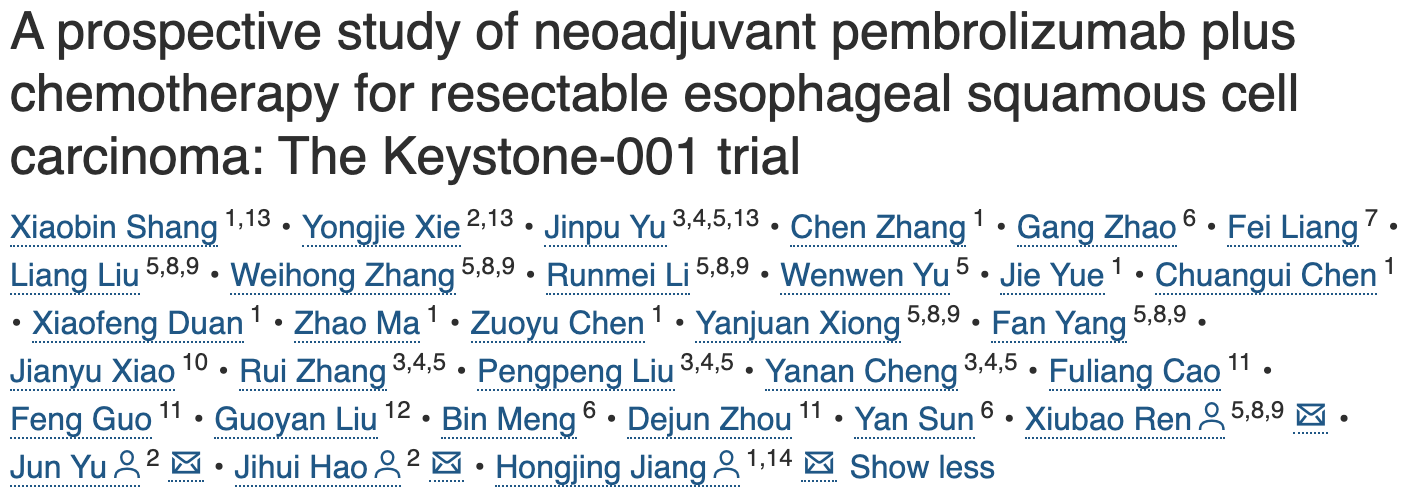
天津医科大学肿瘤医院(食道微创外科\胰腺中心)、天津医科大学肿瘤研究所
Summary
In this phase II study, 47 patients with locally advanced, resectable esophageal squamous cell carcinoma (ESCC) received three cycles of pembrolizumab plus chemotherapy, followed by Da Vinci robot-assisted surgery. The primary endpoints were safety and major pathological response (MPR). Key secondary endpoints included complete pathological response (pCR) and survival. No grade ≥3 adverse events or surgical delays occurred during neoadjuvant therapy. Among 46 patients studied for efficacy, the MPR and pCR rates were 72% and 41%, respectively. After a median follow-up of 27.2 months, the 2-year overall survival (OS) and disease-free survival (DFS) rates were 91% and 89%, respectively. Expansion of TRGC2+ NKT cells in peripheral blood correlated with neoadjuvant treatment effectiveness, which was validated by in vitro organoid experiments and external cancer datasets, and its functional classification and mechanism of action were further explored. These findings show preoperative pembrolizumab plus chemotherapy is a promising therapeutic strategy for resectable ESCC.
摘要
这项II期研究入组了47名局部晚期可切除食管鳞状细胞癌(ESCC)患者,接受了三周期的帕博利珠单抗联合化疗新辅助治疗,随后进行达芬奇机器人辅助手术。主要终点为安全性和主要病理缓解(MPR)。关键次要终点包括完全病理缓解(pCR)和生存期。新辅助治疗期间未出现≥3级不良事件或手术延误。在46名可进行疗效评估的患者中,MPR和pCR分别为72%和41%。经过27.2个月的中位随访后,患者的2年总生存率(OS)和无病生存率(DFS)分别为91%和89%。外周血中TRGC2+ NKT细胞扩增与新辅助治疗的效果相关,该发现通过体外类器官实验及外部癌症数据集验证,并进一步解析其功能分型与作用机制。本发现表明,帕博利珠单抗联合新辅助化疗的治疗方案是可切除ESCC的具有广阔应用前景的治疗策略。
6. Cross-tissue human fibroblast atlas reveals myofibroblast subtypes with distinct roles in immune modulation
跨组织人类成纤维细胞图谱揭示具有不同的肌成纤维细胞亚型在免疫调节过程中的作用

北京大学深圳研究生院化学生物学与生物技术学院、深圳湾实验室肿瘤研究所及天津医科大学肿瘤研究所
Summary
Fibroblasts, known for their functional diversity, play crucial roles in inflammation and cancer. In this study, we conduct comprehensive single-cell RNA sequencing analyses on fibroblast cells from 517 human samples, spanning 11 tissue types and diverse pathological states. We identify distinct fibroblast subpopulations with universal and tissue-specific characteristics. Pathological conditions lead to significant shifts in fibroblast compositions, including the expansion of immune-modulating fibroblasts during inflammation and tissue-remodeling myofibroblasts in cancer. Within the myofibroblast category, we identify four transcriptionally distinct subpopulations originating from different developmental origins, with LRRC15+ myofibroblasts displaying terminally differentiated features. Both LRRC15+ and MMP1+ myofibroblasts demonstrate pro-tumor potential that contribute to the immune-excluded and immune-suppressive tumor microenvironments (TMEs), whereas PI16+ fibroblasts show potential anti-tumor functions in adjacent non-cancerous regions. Fibroblast-subtype compositions define patient subtypes with distinct clinical outcomes. This study advances our understanding of fibroblast biology and suggests potential therapeutic strategies for targeting specific fibroblast subsets in cancer treatment.
摘要
成纤维细胞以其功能多样性而著称,在炎症和癌症中发挥关键作用。本研究通过对11种组织类型、涵盖多种病理状态的517例人类样本的成纤维细胞进行了全面的单细胞RNA测序分析,鉴别出具有普适性和组织特异性的成纤维细胞亚群:病理状态导致成纤维细胞组成显著变化,炎症微环境中免疫调节性成纤维细胞扩增,而在癌症组织中富集具有组织重塑功能的肌成纤维细胞。在肌成纤维细胞类群中,该研究发现了四个转录特征各异、发育起源不同的亚群,其中LRRC15+肌成纤维细胞表现出终末分化的特征。LRRC15+和MMP1+肌成纤维细胞均表现出促瘤潜能——前者促进免疫排斥型肿瘤微环境(TME)形成,后者驱动免疫抑制型TME;而邻近癌旁组织中的PI16+成纤维细胞则具有潜在抗肿瘤功能。成纤维细胞亚群的组成定义了具有不同临床预后的患者分型。本研究深化了对成纤维细胞生物学的理解,并为在癌症治疗中靶向特定成纤维细胞亚群提供了潜在的治疗策略。
7. Spatial oncology: Translating contextual biology to the clinic
空间肿瘤学:环境生物学向临床的转化

美国麻省总医院;美国麻省理工学院和哈佛大学博德研究所
Summary
Microscopic examination of cells in their tissue context has been the driving force behind diagnostic histopathology over the past two centuries. Recently, the rise of advanced molecular biomarkers identified through single cell profiling has increased our understanding of cellular heterogeneity in cancer but have yet to significantly impact clinical care. Spatial technologies integrating molecular profiling with microenvironmental features are poised to bridge this translational gap by providing critical in situ context for understanding cellular interactions and organization. Here, we review how spatial tools have been used to study tumor ecosystems and their clinical applications. We detail findings in cell-cell interactions, microenvironment composition, and tissue remodeling for immune evasion and therapeutic resistance. Additionally, we highlight the emerging role of multi-omic spatial profiling for characterizing clinically relevant features including perineural invasion, tertiary lymphoid structures, and the tumor-stroma interface. Finally, we explore strategies for clinical integration and their augmentation of therapeutic and diagnostic approaches.
摘要
过去两个世纪以来,组织内细胞的显微镜检查一直是诊断性组织病理学发展的核心驱动力。近年来,通过单细胞图谱分析鉴定出的先进分子生物标志物提升了研究者对癌症细胞异质性的了解,但尚未显著改善临床诊疗。将分子图谱分析与微环境特征相结合的空间组学技术有望弥合这一转化鸿沟——其提供的原位空间信息对于解析细胞互作与组织结构至关重要:详述其在细胞间互作、微环境组成、以及免疫逃逸和治疗抵抗相关组织重塑中的发现;重点探讨多组学空间分析在神经周围浸润、三级淋巴结构、肿瘤-基质界面等临床相关特征解析中的新兴作用;最后展望临床整合策略及其对诊疗体系的革新潜力。
8.A pan-cancer single-cell RNA-seq atlas of intratumoral B cells
泛癌单细胞RNA测序解析肿瘤浸润B细胞图谱

英国伦敦大学癌症研究所肿瘤免疫实验室和肺癌实验室
Summary
Tumor-infiltrating B cells play a significant role in tumor development, progression, and prognosis, yet a comprehensive classification system is lacking. To address this gap, we present a pan-cancer single-cell RNA sequencing (scRNA-seq) atlas of tumor-infiltrating B and plasma cells across a large sample cohort. We identify key B cell subset signatures, revealing distinct subpopulations and highlighting the heterogeneity and functional diversity of these cells in the tumor microenvironment. We explore associations between B cell subsets and checkpoint inhibitor therapy responses, finding subset-specific effects on overall response. Additionally, we examine B and T cell crosstalk, identifying unique ligand-receptor pairs for specific B cell subsets, spatially validated. This comprehensive dataset serves as a valuable resource, providing a detailed atlas that enhances the understanding of B cell complexity in tumors and opens new avenues for research and therapeutic strategies.
摘要
浸润性 B 细胞在肿瘤发生、发展和预后中起着重要作用,但目前尚缺乏着全面的分类系统。为了填补这一空白,该研究构建了泛癌种大样本队列的肿瘤浸润B细胞与浆细胞单细胞RNA测序(scRNA-seq)图谱。该研究揭示了关键B细胞亚群特征:不仅解析了具有功能差异的亚群分布,更凸显了肿瘤微环境中B细胞的异质性与功能多样性。该研究探索了B细胞亚群与免疫检查点抑制治疗应答之间的关联,发现了特定亚群对总体反应的差异化影响。此外,通过解析B-T细胞互作网络,鉴定出多个亚群特异性配体-受体对并经空间验证。该综合性数据集为重要资源平台,其构建的精细化图谱将深化对肿瘤B细胞复杂性的认知,并为治疗策略开发开辟新路径。
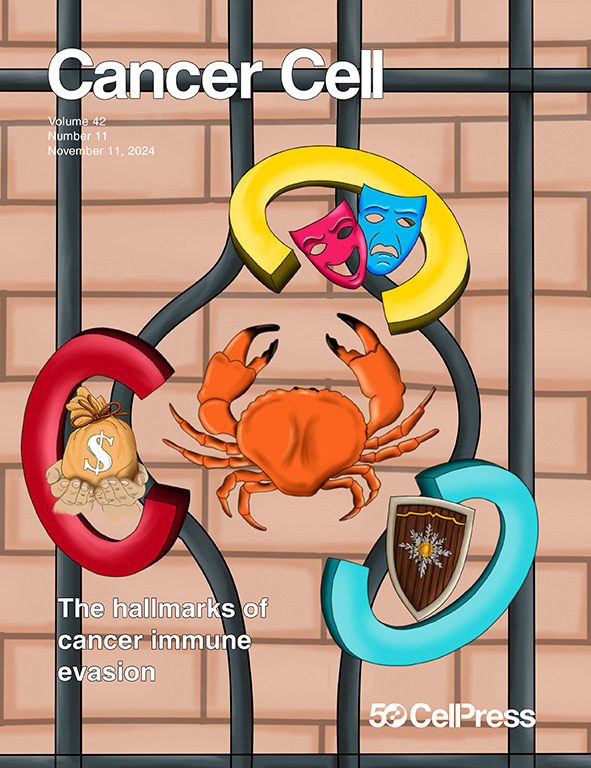
Nov 11, 2024 Volume 42 Issue 11
其中Commentaries 2篇,Letter 1篇,Previews 4篇,Spotlights 2篇,Review 1篇,Articles 6篇,Report 1篇,Correction 1篇,共18篇。
1. The activity of tertiary lymphoid structures in high grade serous ovarian cancer is governed by site, stroma, and cellular interactions
高等级浆液性卵巢癌中三级淋巴结构的活性受发生部位、间质和细胞相互作用共同调控

美国匹兹堡大学免疫系、UPMC希尔曼癌症中心
Summary
Most high grade serous ovarian cancers (HGSOC) originate in the fallopian tube but spread to the ovary and peritoneal cavity, highlighting the need to understand antitumor immunity across HGSOC sites. Using spatial analyses, we discover that tertiary lymphoid structures (TLSs) within ovarian tumors are less developed compared with TLSs in fallopian tube or omental tumors. We reveal transcriptional differences across a spectrum of lymphoid structures, demonstrating that immune cell activity increases when residing in more developed TLSs and produce a prognostic, spatially derived TLS signature from HGSOC tumors. We interrogate TLS-adjacent stroma and assess how normal mesenchymal stem cells MSCs (nMSCs) may support B cell function and TLS, contrary to cancer-educated MSCs (CA-MSCs) which negate the prognostic benefit of our TLS signature, suggesting that pro-tumorigenic stroma could limit TLS formation.
摘要
大多数高级别浆液性卵巢癌(HGSOC)起源于输卵管,但会转移至卵巢和腹腔,这凸显了解析HGSOC不同部位抗肿瘤免疫特征的必要性。通过空间转录组分析,研究发现卵巢肿瘤内的三级淋巴结构(TLS)发育程度低于输卵管或网膜肿瘤中的TLS。该研究揭示了淋巴结构连续谱的转录差异,表明免疫细胞的活性随TLS发育成熟度升高而增强,并基于HGSOC肿瘤构建具有预后价值的空间特征性TLS标签。通过解析TLS邻近间质,发现正常间质干细胞(nMSC)可支持B细胞功能及TLS形成,而癌变间质干细胞(CA-MSC)则会消除TLS标签的预后价值,提示促肿瘤间质可能限制TLS发育。
2. Overcoming tyrosine kinase inhibitor resistance in lung cancer brain metastasis with CTLA4 blockade
CTLA4阻断疗法克服肺癌颅内转移中酪氨酸激酶抑制剂的耐药性

复旦大学上海医学院附属华山医院神经外科、复旦大学脑转化医学研究所
Summary
Lung cancer brain metastasis (LCBM) poses a significant clinical challenge due to acquired resistance to tyrosine kinase inhibitor (TKI) treatment. To elucidate its underlying mechanisms, we employed single-cell RNA sequencing analysis on surgically obtained LCBM samples with diverse genetic backgrounds and TKI treatment histories. Our study uncovers that TKI treatment elevates the immune checkpoint CTLA4 expression in T cells, promoting an immune-suppressive microenvironment. This immunomodulation is initiated by tumor-derived HMGB1 in response to TKIs. In LCBM syngeneic murine models with TKI-sensitive or TKI-resistant EGFR mutations, combining CTLA4 blockade with TKIs demonstrates enhanced efficacy over TKI monotherapy or TKIs with PD1 blockade. These findings provide insights into the TKI resistance mechanisms and highlight the potential of CTLA4 blockade in effectively overcoming TKI resistance in LCBM.
摘要
肺癌颅内转移(LCBM)因对酪氨酸激酶抑制剂(TKI)产生了获得性耐药,这对肺癌脑转移(LCBM)的治疗构成了重大临床挑战。为解析其机制,该研究对手术获得的具有不同遗传背景和TKI治疗史的LCBM患者的组织样本进行了单细胞RNA测序分析。研究发现,TKI治疗可上调T细胞的免疫检查点CTLA4的表达,从而促进免疫抑制微环境的形成。这一免疫调节作用是由肿瘤来源的HMGB1响应TKIs治疗时而启动。在携带TKI敏感或耐药的EGFR突变的LCBM同种异体小鼠模型中,联合CTLA4阻断疗法与TKI的疗法显示出比单独使用TKI或TKI联合PD-1阻断疗法具有更高的疗效。该研究不仅深入解析TKI耐药机制,更凸显CTLA4靶向治疗在逆转LCBM耐药中的潜力。
3. Neoadjuvant vidutolimod and nivolumab in high-risk resectable melanoma: A prospective phase II trial
新辅助vidutolimod联合nivolumab治疗高风险可切除黑色素瘤:一项前瞻性II期临床试验
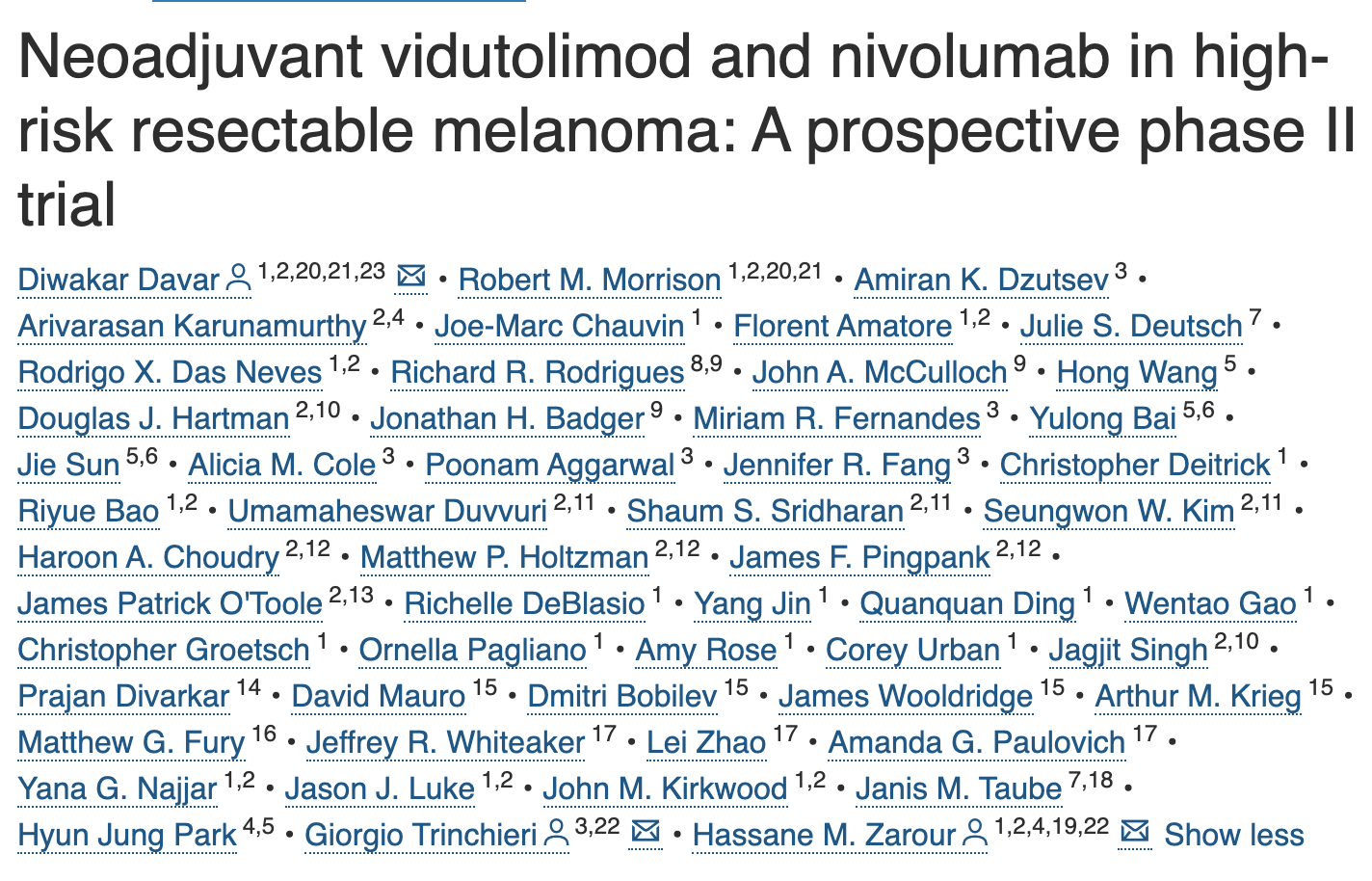
美国匹兹堡大学血液肿瘤科、UPMC希尔曼癌症中心
Summary
Intratumoral TLR9 agonists and anti-PD-1 produce clinical responses and broad immune activation. We conducted a single-arm study of neoadjuvant TLR9 agonist vidutolimod combined with anti-PD-1 nivolumab in high-risk resectable melanoma. In 31 evaluable patients, 55% major pathologic response (MPR) was observed, meeting primary endpoint. MPR was associated with necrosis, and melanophagocytosis with increased CD8+ tumor-infiltrating lymphocytes and plasmacytoid dendritic cells (pDCs) in the tumor microenvironment, and increased frequencies of Ki67+CD8+ T cells peripherally. MPRs had an enriched pre-treatment gene signature of myeloid cells, and response to therapy was associated with gene signatures of immune cells, pDCs, phagocytosis, and macrophage activation. MPRs gut microbiota were enriched for Gram-negative bacteria belonging to the Bacteroidaceae and Enterobacteriaceae families and the small subgroup of Gram-negative Firmicutes. Our findings support that combined vidutolimod and nivolumab stimulates a broad anti-tumor immune response and is associated with distinct baseline myeloid gene signature and gut microbiota. ClinicalTrials.gov identifier: NCT03618641.
摘要
瘤内Toll样受体9(TLR9)激动剂联合抗PD-1治疗能够产生临床应答广泛激活免疫系统。本研究在高风险可切除黑色素瘤患者中开展了一项新辅助TLR9激动剂vidutolimod联合抗PD-1抗体纳武利尤单抗的单臂研究。在31名可评估的患者中,观察到55%的主要病理缓解率(MPR),达到主要终点。MPR与肿瘤坏死、黑色素吞噬现象相关,其微环境中CD8+肿瘤浸润淋巴细胞和浆细胞样树突状细胞(pDC)增多,外周血Ki67+CD8+ T细胞频率升高。MPR患者治疗前骨髓细胞相关基因标签富集,且治疗应答与免疫细胞、pDC、吞噬作用及巨噬细胞活化相关基因特征相关。MPR患者的肠道微生物群中拟杆菌科、肠杆菌科等革兰氏阴性菌及革兰氏阴性厚壁菌门亚群显著富集。本研究证实vidutolimod联合纳武利尤单抗可激发广泛抗肿瘤免疫应答独特的基线髓系基因特征及肠道菌群相关(临床试验注册号:NCT03618641)。
4. Long-term breast cancer response to CDK4/6 inhibition defined by TP53-mediated geroconversion
TP53介导的衰老转化决定乳腺癌对CDK4/6抑制剂的长期应答
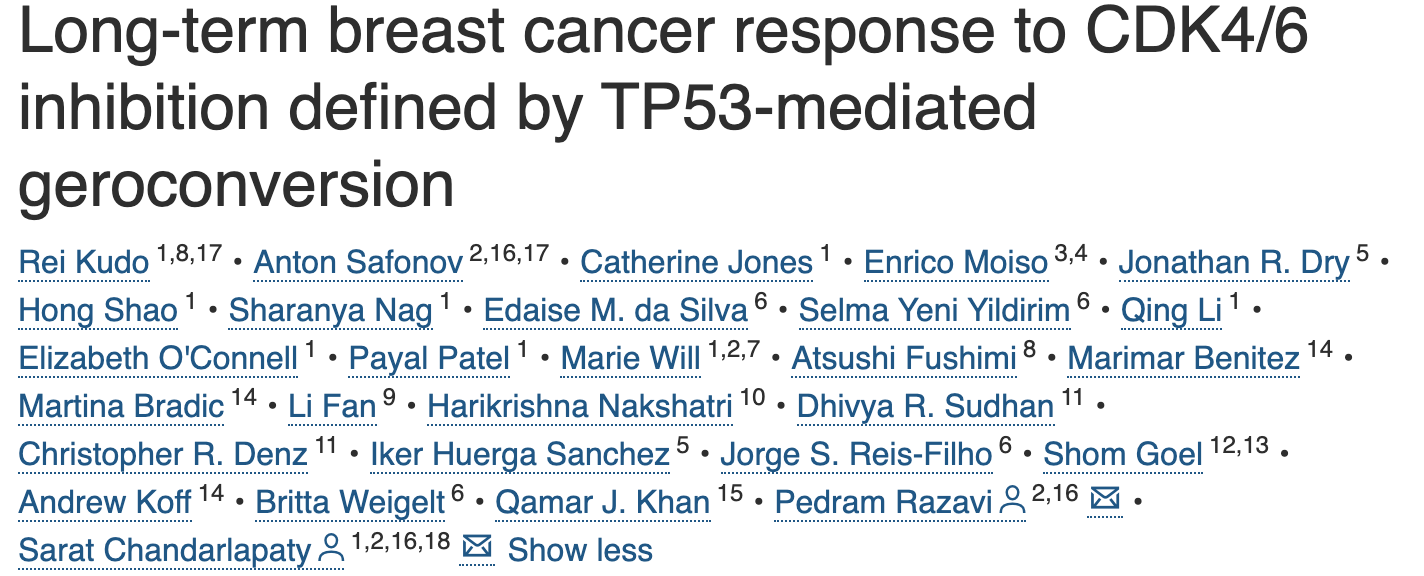
美国纪念斯隆-凯特琳癌症研究中心、东京慈惠会医科大学
Summary
Inhibition of CDK4/6 kinases has led to improved outcomes in breast cancer. Nevertheless, only a minority of patients experience long-term disease control. Using a large, clinically annotated cohort of patients with metastatic hormone receptor-positive (HR+) breast cancer, we identify TP53 loss (27.6%) and MDM2 amplification (6.4%) to be associated with lack of long-term disease control. Human breast cancer models reveal that p53 loss does not alter CDK4/6 activity or G1 blockade but instead promotes drug-insensitive p130 phosphorylation by CDK2. The persistence of phospho-p130 prevents DREAM complex assembly, enabling cell-cycle re-entry and tumor progression. Inhibitors of CDK2 can overcome p53 loss, leading to geroconversion and manifestation of senescence phenotypes. Complete inhibition of both CDK4/6 and CDK2 kinases appears to be necessary to facilitate long-term response across genomically diverse HR+ breast cancers.
摘要
抑制细胞周期CDK4/6激酶显著改善乳腺癌的治疗效果。然而,只有少数患者能长期实现病情控制。该研究通过对大样本量的转移性激素受体阳性(HR+)乳腺癌患者队列进行临床分析,发现TP53基因缺失(27.6%)和MDM2扩增(6.4%)与缺乏长期疾病控制有关。人源乳腺癌模型研究表明,p53基因缺失不会改变 CDK4/6的活性或G1期阻滞作用,反而会作用于CDK2激酶诱导对药物不敏感的p130磷酸化。磷酸化p130蛋白的持续存在阻碍了DREAM复合物的形成,使促肿瘤的细胞周期重启和进展。CDK2抑制剂可逆转p53基因缺失,驱动衰老转化,并呈现衰老表型。值得注意的是,在基因组多样性的HR+乳腺癌中,需同时完全抑制CDK4/6与CDK2激酶才能实现长期治疗应答。
5. Midkine as a driver of age-related changes and increase in mammary tumorigenesis
Midkine是驱动年龄相关性变化并促进乳腺肿瘤生成增加的关键因子

美国丹娜·法伯癌症研究所、哈佛医学院
Summary
Aging is a pivotal risk factor for cancer, yet the underlying mechanisms remain poorly defined. Here, we explore age-related changes in the rat mammary gland by single-cell multiomics. Our findings include increased epithelial proliferation, loss of luminal identity, and decreased naive B and T cells with age. We discover a luminal progenitor population unique to old rats with profiles reflecting precancerous changes and identify midkine (Mdk) as a gene upregulated with age and a regulator of age-related luminal progenitors. Midkine treatment of young rats mimics age-related changes via activating PI3K-AKT-SREBF1 pathway and promotes nitroso-N-methylurea-induced mammary tumorigenesis. Midkine levels increase with age in human blood and mammary epithelium, and higher MDK in normal breast tissue is associated with higher breast cancer risk in younger women. Our findings reveal a link between aging and susceptibility to tumor initiation and identify midkine as a mediator of age-dependent increase in breast tumorigenesis.
摘要
衰老是癌症发生的关键风险因素,但其内在机制尚不明确。该研究通过单细胞多组学技术解析了大鼠乳腺组织与年龄相关性变化。该研究发现衰老伴随上皮细胞增殖增加、管腔细胞特性丧失及初始B/T淋巴细胞减少。研究还鉴定了一类老年大鼠特有的乳腔前体细胞群,其转录特征呈现癌前病变倾向,并揭示Midkine(Mdk)基因随年龄上调且调控此类衰老相关祖细胞。MDK处理年轻大鼠可通过激活PI3K-AKT-SREBF1信号通路模拟衰老相关改变,并促进了亚硝基-N-甲基脲诱导的乳腺肿瘤发生。在人类中,MDK水平随年龄增长,在人类血液和乳腺上皮中增加,且正常乳腺组织高表达MDK与年轻女性乳腺癌风险增加相关。本研究揭示了衰老与肿瘤发生易感性之间的分子联系,并证实Mdk是介导年龄依赖性乳腺肿瘤生成增加的关键因子。
6. In vivo models of subclonal oncogenesis and dependency in hematopoietic malignancy
造血系统恶性肿瘤中亚克隆肿瘤发生与依赖的体内模型
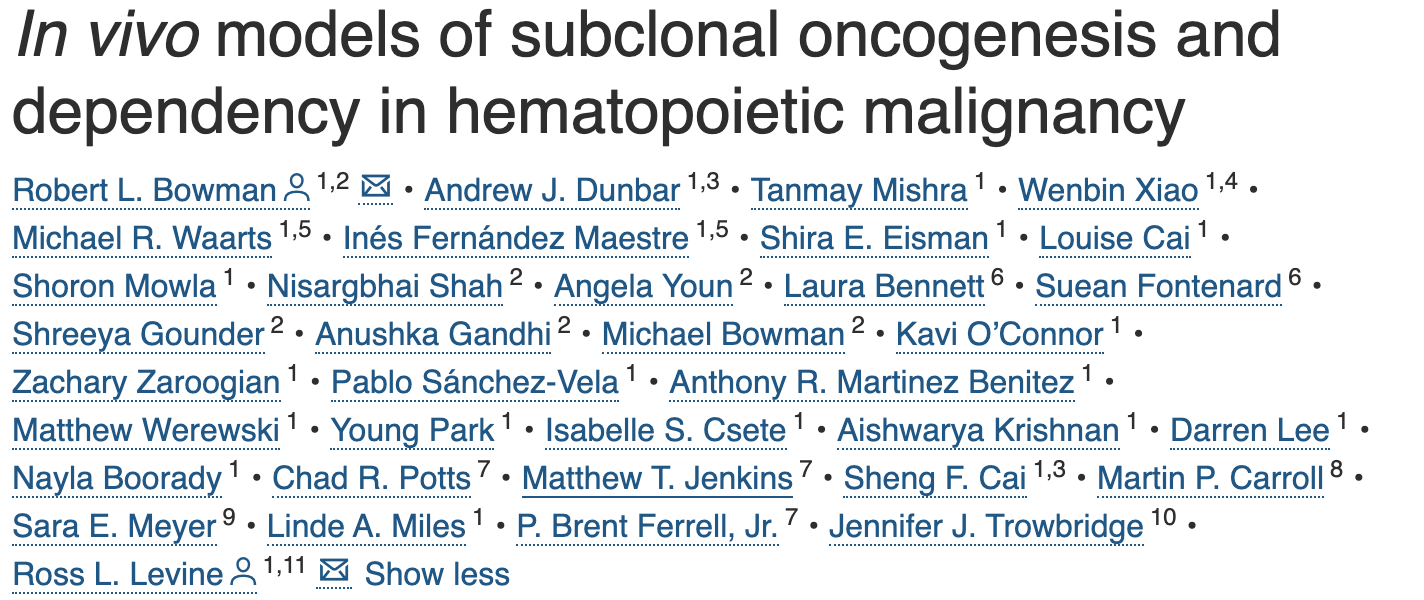
美国纪念斯隆-凯特琳癌症研究中心、宾夕法尼亚大学佩雷尔曼癌症中心
Summary
Cancer evolution is a multifaceted process leading to dysregulation of cellular expansion and differentiation through somatic mutations and epigenetic dysfunction. Clonal expansion and evolution is driven by cell-intrinsic and -extrinsic selective pressures, which can be captured with increasing resolution by single-cell and bulk DNA sequencing. Despite the extensive genomic alterations revealed in profiling studies, there remain limited experimental systems to model and perturb evolutionary processes. Here, we integrate multi-recombinase tools for reversible, sequential mutagenesis from premalignancy to leukemia. We demonstrate that inducible Flt3 mutations differentially cooperate with Dnmt3a, Idh2, and Npm1 mutant alleles, and that changing the order of mutations influences cellular and transcriptional landscapes. We next use a generalizable, reversible approach to demonstrate that mutation reversion results in rapid leukemic regression with distinct differentiation patterns depending upon co-occurring mutations. These studies provide a path to experimentally model sequential mutagenesis, investigate mechanisms of transformation and probe oncogenic dependency in disease evolution.
摘要
癌症演化是一个多层面的生物学过程,通过体细胞突变和表观遗传功能障碍导致细胞增殖和分化的系统性失调。克隆扩增及演化进程由细胞内在与外在选择压力共同驱动,这些压力可以通过单细胞和群体DNA测序技术以更高的分辨率进行高精度解析。尽管基因图谱研究揭示了广泛的基因组变异,但能够模拟并干预演化过程的实验模型系统仍十分有限。本研究整合了多种重组酶工具,建立了从癌前病变向白血病演进的可逆顺序性诱变模型。研究证明,可诱导的Flt3突变与Dnmt3a、Idh2和Npm1突变等位基因存在差异性协同作用,并且突变时序显著改变细胞表型与转录组特征。于是,采用普适性可逆干预策略证实,突变逆转可导致白血病快速消退,其分化模式取决于共存突变类型。这些研究为实验性模拟连续突变事件、解析恶性转化机制及探究疾病演化中的致癌依赖性提供了创新方法体系。
7. A proteogenomic surfaceome study identifies DLK1 as an immunotherapeutic target in neuroblastoma
一项蛋白基因组学和表面蛋白组学研究鉴定出DLK1可作为神经母细胞瘤的免疫治疗新靶点
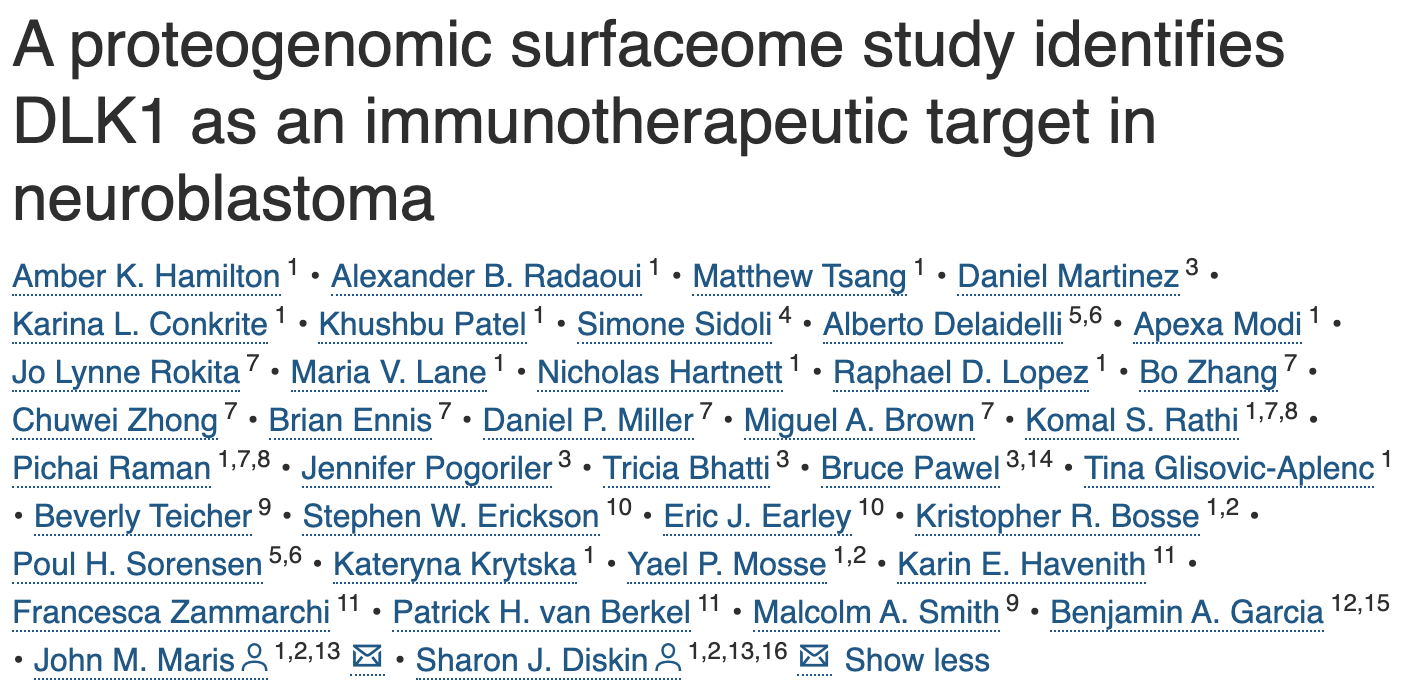
美国费城儿童医院儿童癌症研究中心、美国宾夕法尼亚大学佩雷尔曼医学院
Summary
Cancer immunotherapies produce remarkable results in B cell malignancies; however, optimal cell surface targets for many solid cancers remain elusive. Here, we present an integrative proteomic, transcriptomic, and epigenomic analysis of tumor and normal tissues to identify biologically relevant cell surface immunotherapeutic targets for neuroblastoma, an often-fatal childhood cancer. Proteogenomic analyses reveal sixty high-confidence candidate immunotherapeutic targets, and we prioritize delta-like canonical notch ligand 1 (DLK1) for further study. High expression of DLK1 directly correlates with a super-enhancer. Immunofluorescence, flow cytometry, and immunohistochemistry show robust cell surface expression of DLK1. Short hairpin RNA mediated silencing of DLK1 in neuroblastoma cells results in increased cellular differentiation. ADCT-701, a DLK1-targeting antibody-drug conjugate (ADC), shows potent and specific cytotoxicity in DLK1-expressing neuroblastoma xenograft models. Since high DLK1 expression is found in several adult and pediatric cancers, our study demonstrates the utility of a proteogenomic approach and credentials DLK1 as an immunotherapeutic target.
摘要
癌症免疫疗法在B细胞恶性肿瘤的治疗中展现出显著疗效;然而,多数实体瘤仍缺乏理想的细胞表面治疗靶点。这项研究整合分析神经母细胞瘤(一种高致死性儿童肿瘤)与正常组织的蛋白质组、转录组及表观基因组数据,筛选具有生物学意义的细胞表面免疫治疗靶点。蛋白质基因组学分析鉴定了60个高置信度候选的免疫治疗靶点,本研究优先选择了Delta样典型Notch 配体1(DLK1) 进行深入研究。DLK1的高表达与其超级增强子活性直接相关。免疫荧光、流式细胞术和免疫组化均显示DLK1在细胞表面高表达。短发夹RNA介导的DLK1基因沉默可显著促进神经母细胞瘤细胞分化。靶向DLK1的抗体-药物偶联物(ADCT-701)在DLK1阳性神经母细胞瘤移植瘤模型中表现出强效特异性细胞毒性。鉴于DLK1在多种成人和儿童癌症中高表达,该研究不仅验证了蛋白质基因组学策略的实用性,更为DLK1作为广谱免疫治疗新靶点提供了理论依据。
8. The hallmarks of cancer immune evasion
肿瘤免疫逃逸的核心特征

美国威尔·康奈尔医学院放射肿瘤科、美国克利夫兰诊所癌症中心
Summary
According to the widely accepted “three Es” model, the host immune system eliminates malignant cell precursors and contains microscopic neoplasms in a dynamic equilibrium, preventing cancer outgrowth until neoplastic cells acquire genetic or epigenetic alterations that enable immune escape. This immunoevasive phenotype originates from various mechanisms that can be classified under a novel “three Cs” conceptual framework: (1) camouflage, which hides cancer cells from immune recognition, (2) coercion, which directly or indirectly interferes with immune effector cells, and (3) cytoprotection, which shields malignant cells from immune cytotoxicity. Blocking the ability of neoplastic cells to evade the host immune system is crucial for increasing the efficacy of modern immunotherapy and conventional therapeutic strategies that ultimately activate anticancer immunosurveillance. Here, we review key hallmarks of cancer immune evasion under the “three Cs” framework and discuss promising strategies targeting such immunoevasive mechanisms.
摘要
根据广泛认可的“三E ”模式,宿主免疫系统能够清除恶性前体细胞,并在动态平衡中控制微小肿瘤,从而抑制肿瘤生长,获得能够实现免疫逃逸的遗传或表观遗传学改变。这种免疫逃逸源于多种机制,可归类为新型 “三C ”概念框架:(1) 伪装,使癌细胞逃避免疫识别;(2) 胁迫,直接或间接干扰免疫效应细胞;(3) 细胞保护,使恶性细胞免受免疫细胞毒性的侵袭。阻断肿瘤细胞逃避免疫监视的能力,对于提高现代免疫疗法和传统治疗策略的疗效至关重要,而这些策略最终会激活抗癌免疫监视。在此,本研究回顾了 “三C ”框架下癌症免疫逃逸的关键特征,并讨论了具有广阔前景的针对此类免疫逃逸机制的潜在靶向策略。
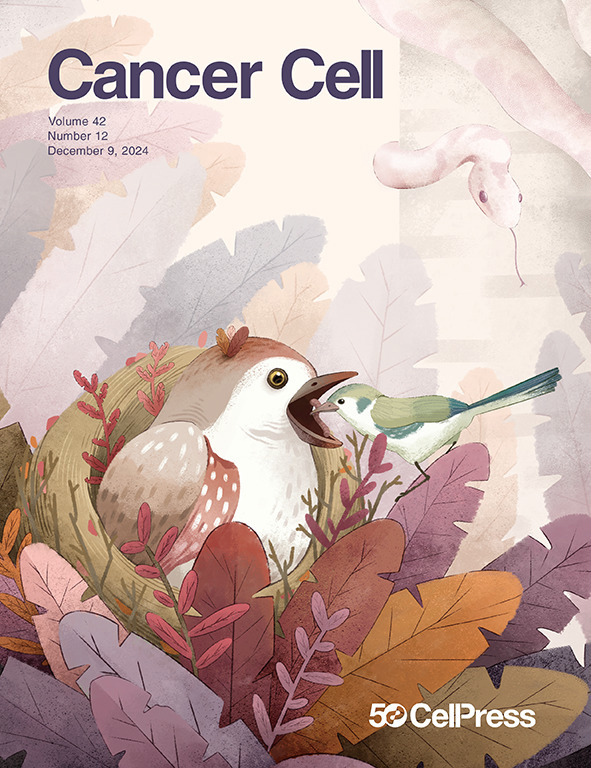
Dec 09, 2024 Volume 42 Issue 12
其中Letter 1 篇,Previews 3篇,Perspective 1篇,Articles 6篇,Report 1篇,Editorial Note 1 篇。
1.Interleukin-1α release during necrotic-like cell death generates myeloid-driven immunosuppression that restricts anti-tumor immunity
坏死样细胞死亡过程中释放的IL-1α可驱动髓系免疫抑制,从而抑制抗肿瘤免疫应答

美国莫菲特癌症中心、南佛罗里达大学
Summary
Necroptosis can promote antigen-specific immune responses, suggesting induced necroptosis as a therapeutic approach for cancer. Here we sought to determine the mechanism of immune activation but found the necroptosis mediators RIPK3 and MLKL dispensable for tumor growth in genetic and implantable models of breast or lung cancer. Surprisingly, inducing necroptosis within established breast tumors generates a myeloid suppressive microenvironment that inhibits T cell function, promotes tumor growth, and reduces survival. This was dependent upon the release of the nuclear alarmin interleukin-1α (IL-1α) by dying cells. Critically, IL-1α release occurs during chemotherapy and targeting this molecule reduces the immunosuppressive capacity of tumor myeloid cells and promotes CD8+ T cell recruitment and effector function. Neutralizing IL-1α enhances the efficacy of single agent paclitaxel or combination therapy with PD-1 blockade in preclinical models. Low IL1A levels correlates with positive patient outcome in several solid malignancies, particularly in patients treated with chemotherapy.
摘要
坏死性凋亡可促进抗原特异性免疫反应,这提示诱导坏死性凋亡可作为癌症治疗的策略。本研究旨在解析其免疫激活机制,但在乳腺癌或肺癌的遗传和移植模型中,坏死性凋亡关键介质RIPK3和MLKL对肿瘤生长并非必需。令人惊讶的是,在已建立的乳腺癌肿瘤模型中诱导坏死性凋亡,会形成抑制T细胞功能、促进肿瘤生长并缩短生存期的髓系抑制性微环境。此过程依赖于死亡癌细胞释放的IL-1α。值得注意的是,化疗过程中同样存在IL-1α释放,靶向该分子可降低肿瘤髓系细胞的免疫抑制能力,促进CD8+ T细胞募集及效应功能。在临床前模型中,中和IL-1α可增强紫杉醇单药或与联合PD-1阻断治疗的抗癌效果。在多项实体瘤实体恶性肿瘤的临床数据分析显示,IL1A低表达与患者良好预后显著相关,尤其在接受化疗的患者群体中更为明显。
2.Itaconate transporter SLC13A3 impairs tumor immunity via endowing ferroptosis resistance
衣康酸转运蛋白SLC13A3通过增加铁死亡抵抗性来抑制抗肿瘤免疫功能
美国密歇根大学医学院、密歇根大学罗杰尔癌症中心
Summary
Immune checkpoint blockade (ICB) triggers tumor ferroptosis. However, most patients are unresponsive to ICB. Tumors might evade ferroptosis in the tumor microenvironment (TME). Here, we discover SLC13A3 is an itaconate transporter in tumor cells and endows tumor ferroptosis resistance, diminishing tumor immunity and ICB efficacy. Mechanistically, tumor cells uptake itaconate via SLC13A3 from tumor-associated macrophages (TAMs), thereby activating the NRF2-SLC7A11 pathway and escaping from immune-mediated ferroptosis. Structural modeling and molecular docking analysis identify a functional inhibitor for SLC13A3 (SLC13A3i). Deletion of ACOD1 (an essential enzyme for itaconate synthesis) in macrophages, genetic ablation of SLC13A3 in tumors, or treatment with SLC13A3i sensitize tumors to ferroptosis, curb tumor progression, and bolster ICB effectiveness. Thus, we identify the interplay between tumors and TAMs via the SLC13A3-itaconate-NRF2-SLC7A11 axis as a previously unknown immune ferroptosis resistant mechanism in the TME and SLC13A3 as a promising immunometabolic target for treating SLC13A3+ cancer.
摘要
免疫检查点阻断疗法(ICB)可诱导肿瘤铁死亡。然而,多数患者对ICB治疗无应答,提示肿瘤可能通过微环境逃逸铁死亡。本研究发现肿瘤细胞通过SLC13A3转运蛋白摄取衣康酸,进而赋予铁死亡抵抗能力,削弱抗肿瘤免疫及ICB疗效。机制层面,肿瘤细胞通过SLC13A3从肿瘤相关巨噬细胞(TAMs)中获取衣康酸,从而激活NRF2-SLC7A11信号轴,逃避免疫介导的铁死亡。通过结构建模和分子对接分析,研究者鉴定出SLC13A3的功能抑制剂——SLC13A3i。巨噬细胞中敲除衣康酸合成关键酶ACOD1,肿瘤细胞中敲除SLC13A3,或用抑制剂SLC13A3i治疗,均可显著增强铁死亡的敏感性,抑制肿瘤进展,并提示ICB疗效。本研究首次揭示肿瘤微环境中SLC13A3-衣康酸-NRF2-SLC7A11调控轴是免疫铁死亡抵抗的新机制,并确立SLC13A3作为治疗SLC13A3阳性肿瘤的潜力免疫代谢靶点。
3.Chemotherapy induces myeloid-driven spatially confined T cell exhaustion in ovarian cancer
化疗诱导卵巢癌发生髓系驱动的空间局限性T细胞耗竭
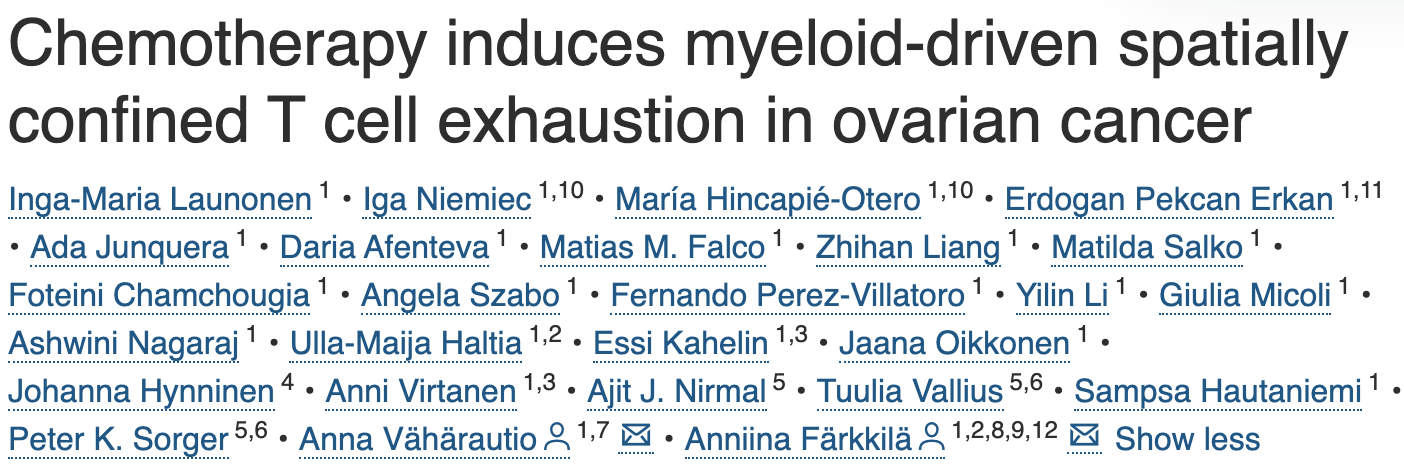
芬兰赫尔辛基大学综合癌症中心、妇产科、肿瘤科
Summary
Anti-tumor immunity is crucial for high-grade serous ovarian cancer (HGSC) prognosis, yet its adaptation upon standard chemotherapy remains poorly understood. Here, we conduct spatial and molecular characterization of 117 HGSC samples collected before and after chemotherapy. Our single-cell and spatial analyses reveal increasingly versatile immune cell states forming spatiotemporally dynamic microcommunities. We describe Myelonets, networks of interconnected myeloid cells that contribute to CD8+ T cell exhaustion post-chemotherapy and show that M1/M2 polarization at the tumor-stroma interface is associated with CD8+ T cell exhaustion and exclusion, correlating with poor chemoresponse. Single-cell and spatial transcriptomics reveal prominent myeloid-T cell interactions via NECTIN2-TIGIT induced by chemotherapy. Targeting these interactions using a functional patient-derived immuno-oncology platform demonstrates that high NECTIN2-TIGIT signaling in matched tumors predicts responses to immune checkpoint blockade. Our discovery of clinically relevant myeloid-driven spatial T cell exhaustion unlocks immunotherapeutic strategies to unleash CD8+ T cell-mediated anti-tumor immunity in HGSC.
摘要
抗肿瘤免疫对高级别浆液性卵巢癌(HGSC)的预后至关重要,但在标准化疗后的免疫应答动态变化尚不明确。本研究对117例化疗前后的HGSC样本进行空间与分子特征解析。单细胞测序和空间分析揭示了更具可塑性的免疫细胞状态,这些细胞形成时空动态的微生态群落。研究者首次描述了"髓系网络"(Myelonets)——化疗后由互连髓系细胞构成的网络结构,其驱动CD8+ T细胞耗竭,并发现肿瘤-基质界面M1/M2极化与CD8+ T细胞耗竭及排斥相关,且伴随化疗耐药。单细胞及空间转录组学分析揭示了化疗后NECTIN2-TIGIT介导的髓系细胞-T细胞互作信号轴。通过功能性患者来源的免疫肿瘤平台靶向该通路,证实匹配肿瘤中NECTIN2-TIGIT信号强度可预测免疫检查点阻断疗效。本研究发现具有临床意义的髓系驱动空间T细胞耗竭机制,为释放CD8+ T细胞介导的抗肿瘤免疫提供了新型治疗策略。
4.Targeting the immune privilege of tumor-initiating cells to enhance cancer immunotherapy
靶向肿瘤起始细胞的免疫特权以增强肿瘤免疫治疗
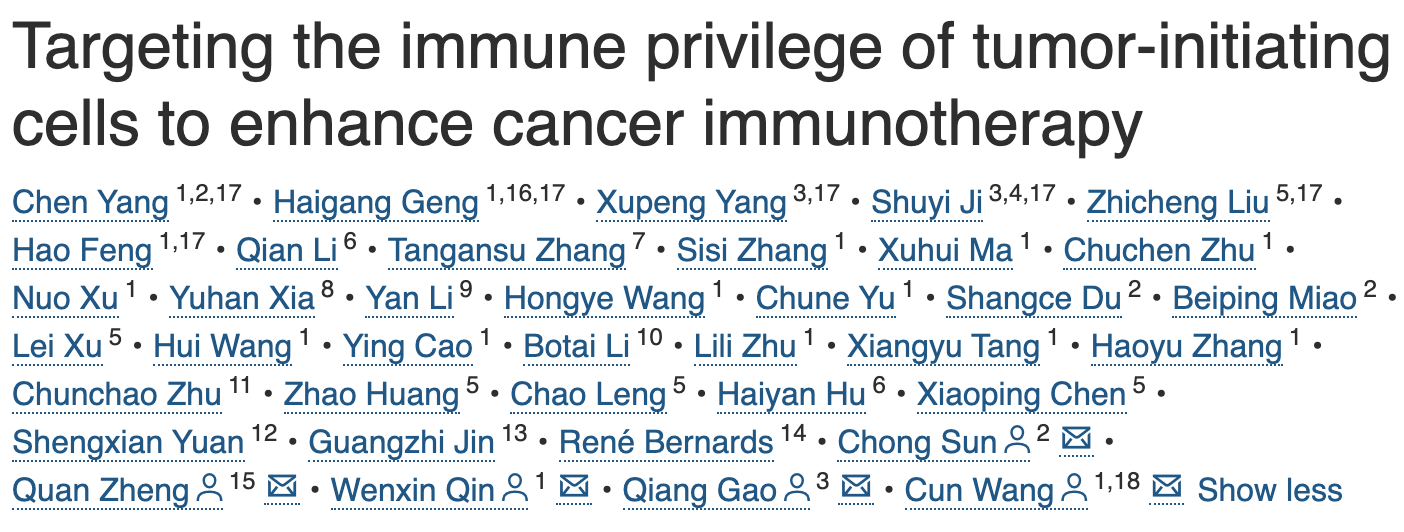
上海交通大学医学院附属仁济医院肝脏外科、德国海德堡癌症研究中心、复旦大学附属中山医院肝癌研究所
Summary
Tumor-initiating cells (TICs) possess the ability to evade anti-tumor immunity, potentially explaining many failures of cancer immunotherapy. Here, we identify CD49f as a prominent marker for discerning TICs in hepatocellular carcinoma (HCC), outperforming other commonly used TIC markers. CD49f-high TICs specifically recruit tumor-promoting neutrophils via the CXCL2-CXCR2 axis and create an immunosuppressive milieu in the tumor microenvironment (TME). Reciprocally, the neutrophils reprogram nearby tumor cells toward a TIC phenotype via secreting CCL4. These cells can evade CD8+ T cell-mediated killing through CCL4/STAT3-induced and CD49f-stabilized CD155 expression. Notably, while aberrant CD155 expression contributes to immune suppression, it also represents a TIC-specific vulnerability. We demonstrate that either CD155 deletion or antibody blockade significantly enhances sensitivity to anti-PD-1 therapy in preclinical HCC models. Our findings reveal a new mechanism of tumor immune evasion and provide a rationale for combining CD155 blockade with anti-PD-1/PD-L1 therapy in HCC.
摘要
肿瘤起始细胞(TICs)具有逃逸抗肿瘤免疫攻击的能力,这可能癌症免疫治疗失败的重要原因。本研究发现CD49f是鉴别肝细胞癌(HCC)中TICs的关键标志物,其效能优于其他常用TIC标志物。CD49f高表达的TICs通过CXCL2-CXCR2轴特异性招募促肿瘤中性粒细胞,并在肿瘤微环境(TME)中构建免疫抑制屏障。反之,中性粒细胞通过分泌CCL4将周围肿瘤细胞重编程为TIC表型。这些细胞可通过CCL4/STAT3诱导且CD49f稳定的CD155表达逃逸CD8+ T细胞介导的杀伤。值得注意的是,CD155的异常表达既是免疫抑制的关键介质,也暴露了TICs的特异性治疗弱点。本研究临床前HCC模型证明,CD155 缺失或抗体阻断均能显著增强抗PD-1治疗的敏感性。这项研究揭示了一种肿瘤免疫逃逸的新机制,并为联合应用CD155阻断与抗PD-1/PD-L1疗法提供了理论依据。
5.Pericancerous cross-presentation to cytotoxic T lymphocytes impairs immunotherapeutic efficacy in hepatocellular carcinoma
癌周抗原交叉呈递介导细胞毒性T淋巴细胞削弱肝癌的免疫治疗效果

中山大学生命科学学院广东省药物功能基因重点实验室、中山大学肿瘤防治中心
Summary
Hyperprogressive disease can occur in cancer patients receiving immune checkpoint blockade (ICB) therapy, but whether and how reactive cytotoxic T lymphocytes (CTLs) exert protumorigenic effects in this context remain elusive. Herein, our study reveals that pericancerous macrophages cross-present antigens to CD103+ CTLs in hepatocellular carcinoma (HCC) via the endoplasmic reticulum (ER)-associated degradation machinery-mediated cytosolic pathway. This process leads to the retention of CD103+ CTLs in the pericancerous area, whereby they activate NLRP3 inflammasome in macrophages, promoting hepatoma progression and resistance to immunotherapy. Our single-cell RNA sequencing (scRNA-seq) and spatial transcriptomics analysis of HCC patients shows that despite their tissue-resident effector phenotype, the aggregation of CD103+ CTLs predicts unfavorable clinical outcomes for HCC patients receiving multiple types of treatment. Correspondingly, therapeutic strategies that redistribute CD103+ CTLs can disrupt this pathogenic interplay with macrophages, enhancing the efficacy of ICB treatment against HCC.
摘要
接受免疫检查点阻断(ICB)治疗的癌症患者可能会出现疾病的过度进展,但此过程中,反应性细胞毒性T细胞(CTLs)是否以及如何发挥促肿瘤作用仍然不清楚。本研究揭示了在肝细胞癌(HCC)中,癌周巨噬细胞通过内质网(ER)相关降解机制介导的细胞质途径,将抗原交叉呈递给CD103+细胞毒性T淋巴细胞。这一过程导致CD103+ CTLs滞留于癌周区域,进而激活巨噬细胞内的NLRP3 炎症小体,促进肝癌的进展诱导免疫治疗耐药。HCC的单细胞RNA测序(scRNA-seq)和空间转录组分析表明,尽管CD103+ CTLs具有组织驻留的效应细胞表型,但其聚集预示着接受多种治疗的HCC患者预后不良。相应地,治疗策略通过重新分布CD103+ CTLs,可破坏其与巨噬细胞的致病性相互作用,从而增强ICB治疗HCC的疗效。
6. Molecular heterogeneity in urothelial carcinoma and determinants of clinical benefit to PD-L1 blockade
尿路上皮癌的分子异质性以及PD-L1阻断治疗的临床获益的决定因素
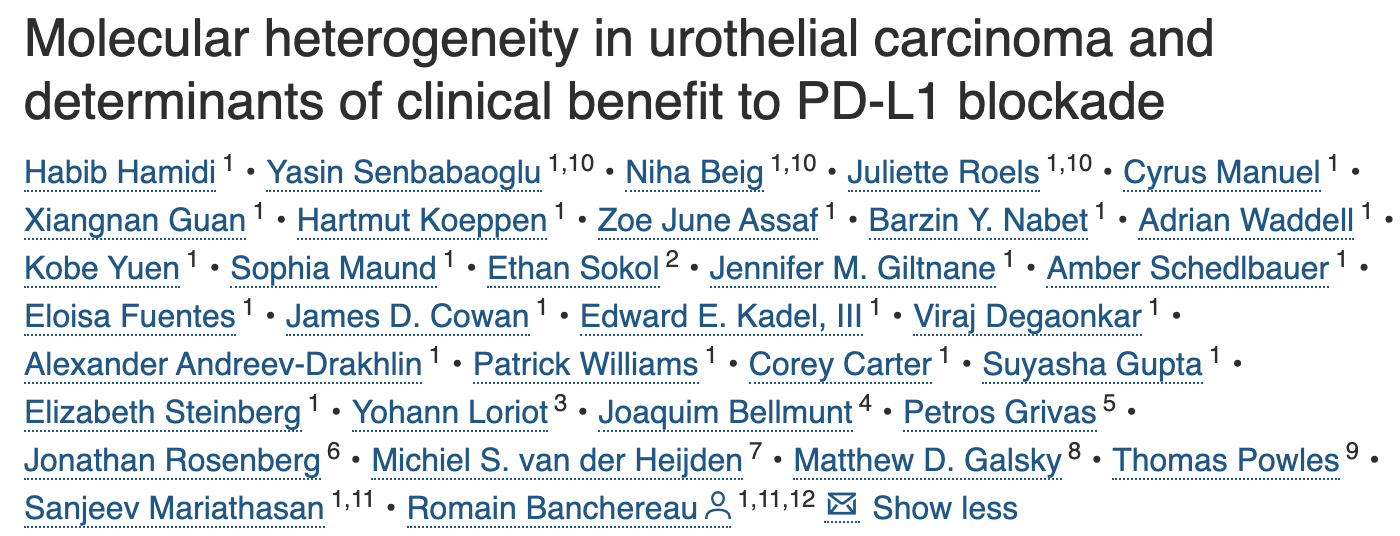
美国基因泰克公司、美国基础医学公司
Summary
Checkpoint inhibitors targeting programmed cell death protein 1 (PD-1)/programmed death-ligand 1 (PD-L1) have revolutionized cancer therapy across many indications including urothelial carcinoma (UC). Because many patients do not benefit, a better understanding of the molecular mechanisms underlying response and resistance is needed to improve outcomes. We profiled tumors from 2,803 UC patients from four late-stage randomized clinical trials evaluating the PD-L1 inhibitor atezolizumab by RNA sequencing (RNA-seq), a targeted DNA panel, immunohistochemistry, and digital pathology. Machine learning identifies four transcriptional subtypes, representing luminal desert, stromal, immune, and basal tumors. Overall survival benefit from atezolizumab over standard-of-care is observed in immune and basal tumors, through different response mechanisms. A self-supervised digital pathology approach can classify molecular subtypes from H&E slides with high accuracy, which could accelerate tumor molecular profiling. This study represents a large integration of UC molecular and clinical data in randomized trials, paving the way for clinical studies tailoring treatment to specific molecular subtypes in UC and other indications.
摘要
靶向程序性细胞死亡蛋白1(PD-1)/程序性死亡配体1(PD-L1)的检查点抑制剂在包括尿路上皮癌(UC)在内的多种肿瘤治疗中取得突破性进展。由于许多患者并未从中获益,需深入理解治疗应答及耐药性的分子机制以改善临床结果。本研究通过对四项晚期随机临床试验中2,803例UC患者的肿瘤样本进行RNA测序(RNA-seq)、靶向DNA测序、免疫组化和数字病理学分析,系统解析其分子特征。机器学习识别出四种转录亚型:管腔荒漠型、间质型、免疫型和基底型。在免疫型和基底型肿瘤中观察到阿替利珠单抗较标准治疗带来的总生存期获益,且两种亚型通过不同的应答机制实现疗。此外,自监督数字病理学方法可基于HE染色切片,高精度预测分子亚型,有望加速肿瘤分子分型进程。本研究在随机试验中实现了UC分子与临床数据的大规模整合,为针对特定分子亚型开展个体化治疗的临床研究铺平了道路,这一模式同样适用于其他种类肿瘤。
7. Elucidating acquired PARP inhibitor resistance in advanced prostate cancer
晚期前列腺癌的获得性PARP抑制剂治疗的耐药机制解析
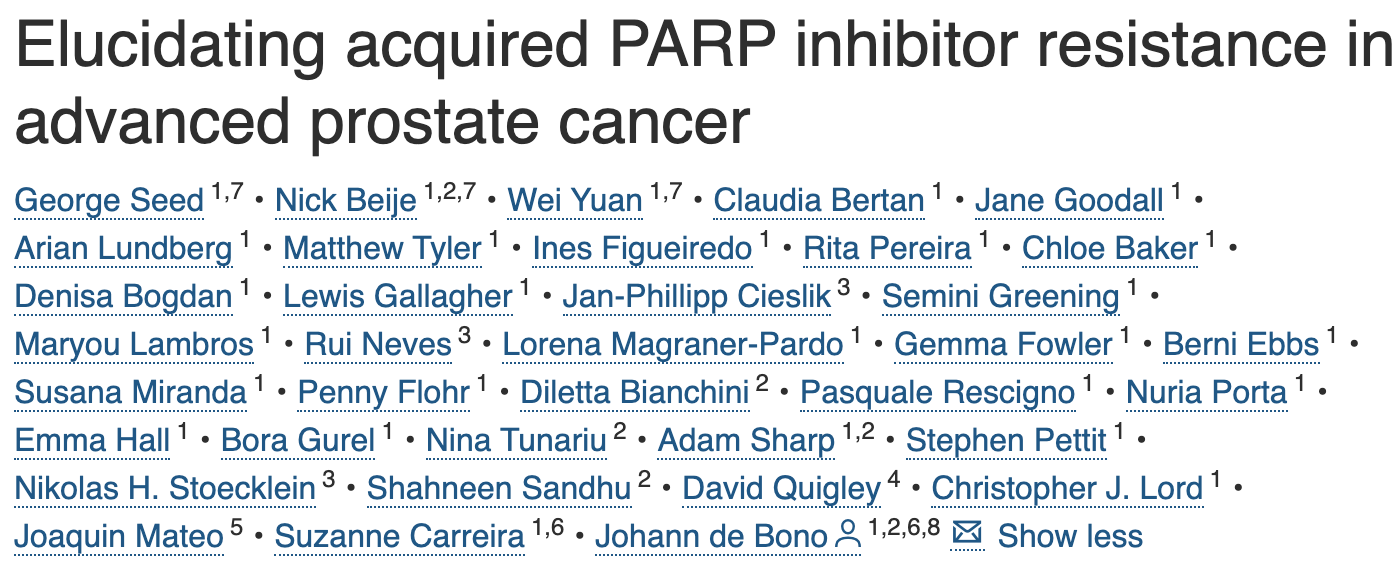
英国伦敦癌症研究所、德国杜塞尔多夫大学
Summary
PARP inhibition (PARPi) has anti-tumor activity against castration-resistant prostate cancer (CRPC) with homologous recombination repair (HRR) defects. However, mechanisms underlying PARPi resistance are not fully understood. While acquired mutations restoring BRCA genes are well documented, their clinical relevance, frequency, and mechanism of generation remain unclear. Moreover, how resistance emerges in BRCA2 homozygously deleted (HomDel) CRPC is unknown. Evaluating samples from patients with metastatic CRPC treated in the TOPARP-B trial, we identify reversion mutations in most BRCA2/PALB2-mutated tumors (79%) by end of treatment. Among reversions mediated by frameshift deletions, 60% are flanked by DNA microhomologies, implicating POLQ-mediated repair. The number of reversions and time of their detection associate with radiological progression-free survival and overall survival (p < 0.01). For BRCA2 HomDels, selection for rare subclones without BRCA2-HomDel is observed following PARPi, confirmed by single circulating-tumor-cell genomics, biopsy fluorescence in situ hybridization (FISH), and RNAish. These data support the need for restored HRR function in PARPi resistance.
摘要
PARP抑制剂(PARPi)对携带同源重组修复(HRR)缺陷的去势抵抗性前列腺癌(CRPC)具有抗肿瘤活性。然而,PARPi的耐药机制尚未完全阐明。尽管BRCA基因恢复突变已被广泛报道,但其临床相关性、发生频率以及生成机制仍不明确。此外,BRCA2纯合缺失(BRCA2-HomDel)型CRPC如何产生耐药性尚属未知。通过评估TOPARP-B试验中接受治疗的转移性CRPC患者样本,该研究发现大多数BRCA2/PALB2突变肿瘤(79%)在治疗结束时出现了回复突变。在由移码缺失介导的回复突变中,60%的突变侧翼存在DNA微同源序列,提示POLQ介导的修复机制参与其中。回复突变的数量及其检测时间与影像学无进展生存期和总生存期显著相关(p<0.01)。对于BRCA2-HomDel患者,PARPi治疗后可筛选出无BRCA2纯合缺失的稀有亚克隆,这一现象通过单细胞循环肿瘤细胞基因组学、活检荧光原位杂交(FISH)及RNA原位杂交得以验证。这些数据表明,恢复同源重组修复功能是PARP抑制剂耐药的关键机制。
8. Myeloid effector cells in cancer
癌症中的髓系效应细胞

荷兰莱顿大学医学中心-肿瘤研究所
Summary
The role of myeloid cells in tumor immunity is multifaceted. While dendritic cells support T cell-mediated tumor control, the highly heterogenous populations of macrophages, neutrophils, and immature myeloid cells were generally considered immunosuppressive. This view has led to effective therapies reinvigorating tumor-reactive T cells; however, targeting the immunosuppressive effects of macrophages and neutrophils to boost the cancer immunity cycle was clinically less successful. Recent studies interrogating the role of immune cells in the context of successful immunotherapy affirm the key role of T cells, but simultaneously challenge the idea that the cytotoxic function of T cells is the main contributor to therapy-driven tumor regression. Rather, therapy-activated intra-tumoral T cells recruit and activate or reprogram several myeloid effector cell types, the presence of which is necessary for tumor rejection. Here, we reappreciate the key role of myeloid effector cells in tumor rejection as this may help to shape future successful immunotherapies.
摘要
髓系细胞在肿瘤免疫中的作用具有多面性。树突状细胞可支持T细胞介导的肿瘤控制,但巨噬细胞、中性粒细胞和未成熟髓系细胞等高度异质性细胞群通常被认为具有免疫抑制作用。这一认知推动了重新激活肿瘤反应性T细胞的有效疗法;然而,针对靶向巨噬细胞和中性粒细胞的免疫抑制效应以增强癌症免疫循环的策略在临床上收效甚微。近期研究在成功免疫治疗的背景下,探讨了免疫细胞的作用,在肯定T细胞核心地位的同时,挑战了T细胞细胞毒性功能是治疗驱动肿瘤消退主要机制的传统观。相反,治疗激活的瘤内 T 细胞可招募、激活或重塑多种髓系效应细胞,而这些细胞类型的存在是肿瘤排斥所必需的。因此,本研究重新审视髓系效应细胞在肿瘤排斥中的关键作用,有望为未来免疫疗法策略的优化指明方向。

汇报人:向琳
导师:赵宇、任建君
审核:王欣怡、李娅妮、任建君
